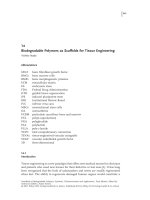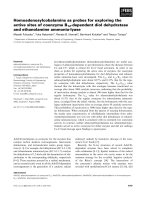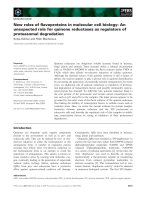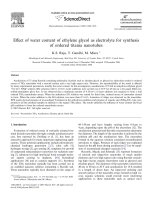Isonicotinic acid-ligated cobalt (II) phthalocyanine-modified titania as photocatalyst for benzene degradation via fluorescent lamp
Bạn đang xem bản rút gọn của tài liệu. Xem và tải ngay bản đầy đủ của tài liệu tại đây (525.95 KB, 6 trang )
Current Chemistry Letters 5 (2016) 93–98
Contents lists available at GrowingScience
Current Chemistry Letters
homepage: www.GrowingScience.com
Isonicotinic acid-ligated cobalt (II) phthalocyanine-modified titania as
photocatalyst for benzene degradation via fluorescent lamp
Joey Andrew A. Valintona,b*, Ji Hye Sona, Jeremiah John O. Zafraa, Gil Nonato C. Santosb,c,
Michael Angelo B. Promentillab,d and Derrick Ethelbhert C. Yua,b
a
Department of Chemistry, College of Science, De La Salle University, 2401 Taft Avenue, Manila, Philippines
Materials Science and Nanotechnology Unit, De La Salle University, 2401 Taft Avenue, Manila, Philippines
c
Department of Physics, College of Science, De La Salle University, 2401 Taft Avenue, Manila, Philippines
d
Department of Chemical Engineering, De La Salle University, 2401 Taft Avenue, Manila, Philippines
b
CHRONICLE
Article history:
Received October 21, 2015
Received in revised form
December 20, 2015
Accepted 7 April 2016
Available online
7 April 2016
Keywords:
Axially-ligated cobalt (II)
phthalocyanine
Photocatalyst
Indoor air pollution
Benzene
Titanium (IV) oxide
Photosensitization
ABSTRACT
The utilization of bis(isonicotinic acid)phthalocyaninatocobalt (II) [CoPc(isa)2] incorporated
on TiO2 has been studied as a photocatalyst to degrade benzene vapor under fluorescent lamp
(indoor light) conditions. The photocatalytic activity of [CoPc(isa)2]-TiO2 compared to TiO2
showed an increase in the extent of degradation. The axial isonicotinic acid ligand attached to
CoPc improved the degradation rate of benzene as compared with unligated CoPc-TiO2 which
may be attributed to the enhancement of electronic structure in the complex due to the
additional isonicotinic acid ligand and its possible attachment to the TiO2 surface through the
carboxylic acid moiety. Therefore, covalently-linked CoPc(isa)2 to TiO2 can enhance the extent
of photodegradation of benzene and other common volatile organic compounds under indoor
lighting conditions.
© 2016 Growing Science Ltd. All rights reserved.
1. Introduction
Indoor air pollution is an environmental problem that is less addressed, yet very important to be
eliminated due to its direct impact on health and the currently increasing indoor human activities
attributed to the concern on outdoor air pollution. Photocatalytic oxidation of air pollutants is one of
the most efficient ways of eliminating indoor air pollutants wherein photocatalysts are irradiated by
incident light to produce electron-hole pairs capable of generating a cascade of redox couples to convert
air pollutants into inert compounds. The photocatalysts are composed of low-band gap semiconductors
which easily facilitate formation of electron-hole pairs needed for the reaction.1 Typically, TiO2 has a
band structure that can be reactive towards most compounds upon light activation.2 Conventionally,
* Corresponding author. Telefax: +63-2-536-0230
E-mail address: (J. A. A. Valinton)
© 2015 Growing Science Ltd. All rights reserved.
doi: 10.5267/j.ccl.2016.4.002
94
TiO2 photocatalysts require high energy UV light incident radiation for it to be activated; hence, a
separate UV lamp is usually required for photocatalytic reactors to be installed for indoor air
purification.3 Thus, the primary goal of this research is to increase the sensitivity of TiO2 towards
visible light, which is present in indoor environments through indoor lighting (fluorescent) which only
emits visible radiation.
One way of harvesting visible light without compromising the electronic band structure of TiO2 is
through sensitization, by incorporating light sensitive molecules which are capable as electron donors
to the photocatalyst.4 Many different photosensitizers (PS) were used onto TiO2, commonly on dye
sensitized solar cell (DSSC) applications.2 Applications of photosensitized TiO2 on indoor air pollutant
degradation applications are of less interest, yet a number of molecules have been used including fullyconjugated molecules and metal macrocycle complexes to mitigate various kinds of pollutants.5
Phthalocyanines (MPc, M = metal), with their applications as molecular conductors6 and catalysts,7 are
very promising additives to TiO2. It has been reported that TiO2 impregnated with MPcs can be used
as visible light activated photocatalysts for degrading sulfur-containing compounds8 and organic
pollutants9 in wastewater.
Modification of the structure of MPcs can also enhance the electronic properties of the complex,
which can also positively affect photosensitization. Aside from the change in the central atom, addition
of substituents on the phthalocyanine periphery can be done, which would influence the light absorption
capabilities of the complex, thereby further enhancing TiO2 photosensitization.10 Moreover, the
substituents can be functionalized to serve as bridging ligands to TiO2 producing an efficient electron
transfer from the phthalocyanine photosensitizer.
This paper reports on axial ligation as a modification option on enhancing the electronic structure
of phthalocyanines as photosensitizer to TiO2. Axial ligands have the capacity to influence the Pc as
photosensitizer through the metal-ligand interaction and it has also been used as an option for
modification on DSSC applications.11 It can also be used as a bridging ligand from the photosensitizer
to the TiO2 surface if the chosen ligand is functionalized. The study involves the usage of isonicotinic
acid as an axial ligand which will act as an axial ligand to cobalt (II) phthalocyanine (CoPc) and may
eventually bridge the photosensitizer onto the TiO2 surface through the carboxylate moiety.
2. Results and Discussion
In order to measure the versatility of the photocatalysts against realistic indoor air pollution
conditions, the chamber is designed to depict a static air environment in which the air is poorly
circulating and the diffusion of the VOC vapor is limited to the convection and weak air currents. In
order to ensure reliability of measuring such conditions, measurements were made onto the chamber
with an empty catalyst which showed a statistically constant concentration and peak area and was
observed to have no significant leakages. This is due to the air possibly circumventing inside the
chamber brought by the sand bath. The conditions were optimized to meet the consistency in the
measurement as the catalyst is placed inside the chamber.
The photocatalytic performance of the axially ligated cobalt (II) phthalocyanine-modified titania
CoPc(IsA)2-TiO2 is compared with the photocatalytic activities of plain TiO2 and cobalt (II)
phthallocyanine-modified titania (CoPc-TiO2). Benzene vapor was used in the test because it is
considered as one of the most common and toxic volatile organic compounds (VOC) indoor air
pollutants. The progress of benzene degradation versus time via the aforementioned photocatalysts are
shown in Fig. 1.
J. A. A. Valinton et al. / Current Chemistry Letters 5 (2016)
CoPc(isa)2-TiO2
TiO2
CoPc-TiO2
60
40
20
CoPc(isa)2-TiO2
TiO2
1.5
- ln (C/C0)
Percent Degradation
80
95
CoPc-TiO2
1.0
0.5
0
-20
0.0
0
50
100
Irradiation Time
0
50
100
Irradiation Time
Fig. 1. Photocatalytic degradation of benzene Fig. 2. Pseudo-first order kinetics plot of
over time
benzene degradation
It is shown that the instantaneous degradation extent using CoPc(isa)2-TiO2 is more effective as
compared to the other two. When the photocatalytic degradation of benzene was assumed to be a
pseudo-first order, it shows that CoPc(isa)2-TiO2 increased the reaction rate constant due to an increase
in the slope of the curve, as shown in Fig. 2.
Upon comparing the statistical correlation of the catalysts with 5% level of significance, the slopes
of CoPc(isa)2-TiO2 and CoPc-TiO2 is significantly nonzero compared to TiO2 which has a slope close
to zero. In comparison between CoPc(isa)2-TiO2 and CoPc-TiO2, the rate constant of the former (k =
0.006409) slightly greater than that of the latter (k = 0.006320) by 1.40% which shows that the axial
ligand functionality does not hinder the photosensitizing capability of CoPc and it slightly improved
the photosensitizer-catalyst interaction.
On a typical photocatalyst like TiO2, photocatalysis can occur by surpassing the band gap by light
excitation. This creates an electron in the conduction band and a hole in the valence band, called
electron-hole pairs, which facilitates redox processes to adjacent molecules. In indoor environments
where ultraviolet radiation is absent, the band structure of TiO2 makes it unable to generate electronhole pairs because the radiant energy provided is not sufficient to overcome the band gap energy for
electron excitation. Visible light PS like CoPc are therefore essential for TiO2 to function on indoor
environments because they donate electrons directly upon excitation to the conduction band of TiO2,
as shown on Fig. 3. The donated electron in the TiO2 conduction band can lead to reduction reactions
whereas the ideal PS may regenerate the electron by an oxidation reaction. The PS-TiO2 composite can
then produce an ideal redox couple which can activated by visible light.
Fig. 3. Mechanism of TiO2 photosensitization
Fig. 4. Structure of CoPc(isa)2 on TiO2 surface
Cobalt (II) phthalocyanine has already been used both as a catalyst12 and a visible light
photosensitizer for photocatalytic reactions.8 Because of this, CoPc with TiO2 can be versatile in
different kinds of lighting conditions. The axial ligation of CoPc allows enhancement of the electronic
capabilities of the complex and functionalize the complex to be used for molecular design. In the study,
96
isonicotinic acid was used because of its rigidity due to the pyridine ring and its assembly to TiO2 via
its carboxylic acid moiety, a common functionality that provides attachments to metal oxides13. The
slight improvement in the photocatalytic degradation therefore may be attributed to the isonicotinic
acid acting as a bridging ligand to both the cobalt (II) and the titanium in the surface of TiO2, as shown
in Fig. 4. This covalent attachment can very essential for an efficient electron transport from
photosensitizer to TiO2.
The scheme of photosensitization, therefore, using CoPc(isa)2-TiO2 is quite the same with other
mechanisms4 which involves an electron transfer from the excited complex to the TiO2 conduction
band. The TiO2 will be the site for reduction which can react to adjacent oxygen molecules to form
reactive oxygen species that degrades pollutants. It has the possibility that CoPc can also interact with
the adjacent gaseous molecules to regenerate the electron loss. In the experiment, however, Co2+ which
can be the plausible site for interaction is unavailable due to the coordination of the axial ligands.
Despite the limitations of the photosensitizer, CoPc(isa)2 seemed to perform more efficiently than
CoPc. Nevertheless, the efficacy of CoPc with an added axial ligand has not affected the process of
photosensitization of TiO2.
3. Conclusion
The study has shown that axially ligated-CoPc with TiO2 (CoPc(isa)2-TiO2) photocatalyst has
exhibited an increase in the efficiency of the photocatalytic degradation of benzene vapor as compared
with its TiO2 and CoPc-TiO2 counterparts, under ambient indoor lighting (fluorescent lamp).
Acknowledgement
This project is funded under the Interdisciplinary Research Program of the University Research
Coordination Office (URCO) of De La Salle University.
4. Experimental
4.1. In situ synthesis of bis(isonicotinic acid)phthalocyaninatocobalt (II), CoPc(isa)2
In a round-bottom flask, 0.25 mg (0.875 mmol) cobalt (II) phthalocyanine (~92% dye content beta
form, Tokyo Chemical Industry) was mixed with 0.25 mg (2.03 mmol) isonicotinic acid (ACS grade,
Sigma-Aldrich) and was then dissolved in 250 mL of 1:1 THF:methanol. The mixture was then purged
and enveloped with nitrogen and was refluxed at room temperature for 72 hours. The mixture was then
filtered and the residue was left at room temperature to dry. The residue appears to be blue-green in
color. Yield: 71.42%
ESI-MS (negative mode): [CoPc]- = 571.0666 (calculated: 571.49 m/z), [CoPc(isa)]- = 693.084
(calculated: 694.61 m/z), [Co(isa)2]2- = 606.0350 (calculated: 610.34 m/z)
Differential Thermal Analysis showed endothermic process at 200-275ºC (isonicotinic acid
detachment) and at 500-650ºC (phthalocyanine decomposition).
4.2. Photocatalyst Preparation
In a mortar and pestle, 0.020 g of CoPc(isa)2 and 0.5 g of anatase TiO2 (powder 99.8%, SigmaAldrich) were grinded with drops of Joy Dishwashing Liquid and diluted acetic acid added to the
mixture forming a thick paste. The paste was then coated evenly on one side of a 2.5 cm by 7.5 cm
microscopic glass slide followed by sintering on a hotplate at 200ºC for 20 minutes. Another
photocatalyst was made from 0.5 g of anatase TiO2 and 0.020 g of CoPc using the same procedure. The
J. A. A. Valinton et al. / Current Chemistry Letters 5 (2016)
97
photocatalyst made from only 0.5 g of TiO2 was made with a sintering temperature of 300ºC for 20
minutes.
4.3. Fluorescent (Indoor) Light Photocatalytic Degradation of Benzene Vapor
The oxidation of benzene vapor was carried out in a fabricated chamber made out of glass with
dimensions and details shown in Fig. 4. The chamber was constructed with a removable top to place
the glass plates inside with the catalyst facing up. All sides were secured with duct tape to prevent
possible vapor leakages. The gastight port is made out of a round PVC fitting with a length of 3 cm and
a diameter of 2.5 cm and was capped with a rubber septum with the same diameter. The chamber is
situated under a sand bath on a hotplate to regulate temperature. The whole setup was placed in a fume
cupboard equipped with a 65 W fluorescent lamp which served as the light source.
Fig. 5. Schematic of the fluorescent light photocatalytic degradation chamber
The CoPc(isa)2-TiO2 photocatalyst was placed inside the chamber which was then securely sealed.
With the fluorescent light turned off, 100 μL of reagent grade liquid benzene was injected onto the
chamber. The chamber was then heated to 80ºC for ten minutes to evaporate all the benzene before the
irradiation starts. 50-μL gas sample increments were collected before irradiation and in 15-minute
intervals after irradiation using a gas-tight syringe. The benzene response of the samples was measured
using a Perkin Elmer Clarus 500 Gas Chromatograph – Mass Spectrometer with an Elite-5MS capillary
column (length 30 m, unternal diameter 0.25 mm, film thickness 0.5 μm). The injection temperature of
the chromatograph was set to 250ºC and the oven temperature is at 60ºC. Each run was set for five
minutes and the area of the peak at the 1.8 min retention time was measured.
The extent of benzene degradation was measured assuming that the concentration of the benzene
in the gas collected is directly proportional with the peak areas obtained. Due to this assumption,
percentage degradation is equivalent to the difference between the peak areas at a certain irradiation
period with respect to the unirradiated gas sample, as shown in Eq. (1):
%
,
(1)
98
where A0 is the peak area obtained before irradiation and A is the peak area obtained on a certain time
period. To measure the photocatalytic activity of each, the oxidation of benzene was assumed to be a
pseudo-first order reaction. The correlation of the concentrations (based on the peak areas) and the
irradiation time was obtained using Eq. (2):
ln
ln
(2)
where c0 is the initial concentration in the gas sample and c is the concentration of the gas sample at
time t. The rate constant of the reaction is represented by k which served as the point of comparison for
catalytic efficiency.
References
1 Linsebigler, A., Lu, G., and Yates, J. (1995) Photocatalysis on TiO2 Surfaces: Principles,
Mechanisms, and Selected Results. Chem. Rev., 95 (3) 735-758.
2 Hashimoto, K., Irie, H. and Fujishima, A. (2005) TiO2 Photocatalysis: A Historical Overview and
Future Prospects. Jpn. J. Appl. Phys., 44 (12), 8269-8285.
3 Destaillats, H., Sleiman, M., Sullivan, D., Jaquinod, C., Sablayrolles, J. and Molins, L. (2012) Key
parameters influencing the performance of photocatalytic oxidation (PCO) air purification under
realistic conditions. App. Catalysis B: Environmental, 128, 159-170.
4 Kumar, S. and Devi, L. (2011) Review on Modified TiO2 Photocatalysis under UV/Visible Light:
Selected Results on Related Mechanisms on Interfacial Charge Carrier Transfer Dynamics. J. Phys.
Chem. A., 115 (46) 13211-13241.
5 Wöhrle, D., Kaneko, M., Nagai, K., Suvorova, O. and Gerdes, R. (2009). Environmental Cleaning
by Molecular Photocatalysts, in: Okada, T. and Kaneko, M. (Eds) Molecular Catalysts for Energy
Conversion. Springer-Verlag, Heidelberg, 263-297.
6 Inabe, T. and Tajima, H. (2004). Phthalocyanines – Versatile Components of Molecular Conductors.
Chem. Rev,, 104 (11), 5503-5534.
7 Iliev, V., Alexiev, V., and Bilyarska, L. (1999). Effect of metal phthalocyanine complex aggregation
on catalytic and photocatalytic oxidation of sulfur containing compounds. J. Mol. Catalysis A:
Chem., 137 (1-3) 15-22.
8 Iliev, V., Tomova, D., Bilyarska, L., Prahov, L. and Petrov. L. (2003). Phthalocyanine modified
TiO2 or WO3 – catalysts for photooxidation of sulfide and thiosulfate ions upon irradiation with
visible light. J. Photochem. Photobiol. A: Chem., 159 (3) 281-287.
9 Iliev, V. (2002). Phthalocyanine-modified titania – catalyst for photooxidation of phenol by
irradiation with visible light. J. Photocchem. Photobiol. A: Chem., 151 (1-3), 195-199.
10 Wang, Z. Mao, W., Chen, H., Zhang, F., Fan, X. and Qian, G. (2006). Copper (II) phthalocyanine
tetradulfonate sensitized nanocrystalline titania photocatalyst: Synthesis in situ and photocatalysis
under visible light. Catalysis Communications, 7 (8), 518-522.
11 O’Regan, B., Lopez-Duarte, I., Martinez-Diaz, V., Forneli, A., Albero, J., Morandeira, A.,
Palomares, E., Torres, T. and Durrant, J.R. (2008). Catalysis of Recombination and its Limitation
on Open Circuit Voltage for Dye Sensitized Photovoltaic Cells Using Phthalocyanine Dyes. J. Am.
Chem. Soc., 130 (10) 2906-2907.
12 Paez-Mozo, E., Gabriunas, N., Maggi, R., Acosta, D., Ruiz, P., & Delmon, B. (1994). Selective
olefin oxidation with cobalt phthalocyanine encapsulated in Y-zeolite. J. Mol. Catalysis, 91 (2)
251-258.
13 Zanotti, G., Angelini, N., Notarantonio, S., Paoletti, A.M., Pennesi, G., Rossi, G., Lembo, A.,
Colonna, D., Di Carlo, A., Reale A., Brown, T.M., & Calogero, G. (2010) Bridged phthalocyanine
systems for sensitization of nanocrystalline TiO2 films. Int. J. Photoenergy, Accepted Manuscript
(DOI: 10.1155/2010/136807)









